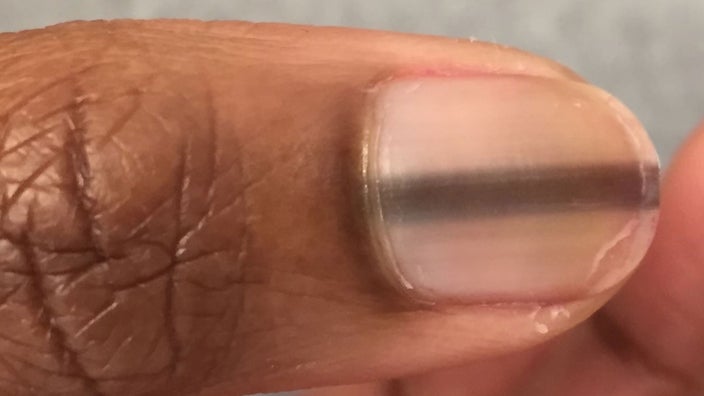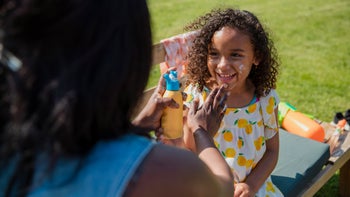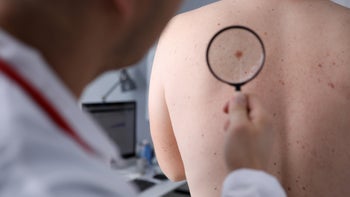
Skin Cancer in Darker Skin Tones: Statistics, Pictures, and Prevention
Key takeaways:
Skin cancer in Black people is less common, but it can happen.
There’s often a delay in the diagnosis of skin cancer in people with darker skin tones.
If you see anything suspicious on your skin or nails, see a dermatologist right away.
Table of contents

Many people don’t realize that skin cancer can affect people with all different shades of skin — including Black people and people with brown skin tones. All the same, skin cancer rates in people with darker skin tones are much lower than in fairer skin. One reason for this is that pigmented skin provides some protection from cancer.
Skin cancer happens when skin cells grow out of control. And when people with darker skin tones do get skin cancer, it’s often bigger, more advanced, and deadlier.
And, there’s a lack of awareness among healthcare professionals and people when it comes to spotting early skin cancer in dark skin. This can lead to delays in diagnosis — or missed diagnosis.
Here are some tips for recognizing different types of skin cancer across different skin tones.
Most common types of skin cancer that affect people of color
There are three main types of skin cancer. Because the skin is made up of layers, the different skin cancer types are named after the type of skin cell that becomes cancerous.
Squamous cells make up the top layers while basal cells are on the bottom layer. Melanocytes — the cells that make pigment — are sprinkled in the bottom layer between basal cells.
Let’s take a look at how the three main types of skin cancer affect people with darker skin tones.
1. Basal cell carcinoma
Basal cell carcinoma (BCC) is the least dangerous form of skin cancer. It also represents about 25% of skin cancer in people of color, according to a 2016 study.
BCCs usually develop on skin that’s often exposed to the sun, most commonly the head and neck. While BCCs rarely ever spread, they can cause damage to surrounding tissues.
Treatment is the same regardless of skin color. In most cases, surgical removal or destruction cures it completely.
2. Squamous cell carcinoma
Squamous cell carcinomas (SCCs) are more aggressive than BCCs, but not as dangerous as melanomas. SCC is the most common type of skin cancer that affects Black people and South Asian people. In people with darker skin tones, this type of cancer is more likely to be aggressive and deadly compared to people with light skin.
3. Malignant melanoma
Malignant melanomas (MMs) are among the most dangerous types of skin cancer in people of all races and skin tones — it could even be deadly in some cases. Fortunately, it’s also the least common.
Surgery alone can cure most malignant melanomas if they’re found early enough. If the cancer has spread, treatment tends to get more complicated. This may require surgery or medications given through the blood like chemotherapy, targeted therapy, or immunotherapy.
What does skin cancer look like in Black people and brown skin tones?
If you look up skin cancer online, you’ll probably find pictures of what it looks like in light skin. But skin cancers look different in darker skin tones. Here’s what to look for — with pictures.
Basal cell carcinomas
BCCs are skin growths usually found in areas exposed to the sun, like the face, neck, or chest. They’re often darker-colored growths (like an onyx). Blood vessels may or may not be visible. Sometimes there’s a central open sore that doesn’t heal.


In lighter skin, BCCs are usually pink or red bumps that can have a sore in the middle and blood vessels may be visible. They often appear in sun-exposed areas, but can also happen on the torso or legs.

Squamous cell carcinomas
SCCs can be in sun-exposed areas, but they can also hide in scars and areas that get less sun exposure. They can look like pink, violet, or dark-colored warts, bumps. They can also be sores that bleed and don’t heal.


In lighter skin, SCCs usually appear in areas normally exposed to the sun, like the face, neck, and chest. They can appear like red warty bumps or sores that don’t heal.

Malignant melanomas
A melanoma looks like an irregular brown or black growth. In darker skin tones, melanoma is more common on the sole of the foot, or palm of the hand. It’s also more likely to appear as a dark streak in the nail that changes over time.


In lighter skin, melanomas have the same appearance. But they’re more common on the trunk and legs.

Major risk factors for skin cancer in people with darker skin tones
If you have darker skin, you can still get skin cancer from ultraviolet (UV) rays even if you don’t sunburn. While the skin pigment melanin does protect you to a certain degree, there’s no such thing as a safe tan. In fact, just like in fair skin, sun exposure is a major risk factor for BCC in people with darker skin tones, too.
Other risk factors for SCC and MM in people with darker skin tones include skin scarring and inflammation, for example:
If you have scars, it’s important to keep an eye on them. Watch for new discoloration, growing bumps, or sores that don’t heal in or around those bumps. If you notice something different, it’s best to show a dermatologist right away.
How can I prevent skin cancer if I have dark skin?
The best way to prevent skin cancer — no matter your skin color — is to protect your skin from the sun. The sun’s UV rays damage skin across skin types. So, enjoy the sun in moderation, but protect yourself at the same time. You can do this by avoiding direct sunlight in the middle of the day. Instead, seek shade.
Use sun-protective clothing or sunscreen to make sure your skin doesn’t darken too much or burn. To ensure maximum protection, choose a sunscreen that is:
Water resistant
Broad spectrum (i.e., protects against UVA and UVB)
SPF 30 or higher
Apply sunscreen to your skin 20 minutes before you go outside. You’ll need a nickel-sized dollop for your face and a shot glass amount for your body to get the SPF on the label. While you’re outside, reapply every 2 hours or after swimming and sweating. There are also tinted products that blend well into dark skin and help prevent hyperpigmentation.
How to check for moles and signs of skin cancer?
Everyone, regardless of skin color, should learn how to check their skin for possible skin cancer. A self-exam for skin cancer is a full-body inspection that you do yourself. You’ll need a full-length mirror and a hand mirror to check your skin from head to toe.
If you have a darker skin tone, pay special attention to hard-to-see areas like:
The bottoms of your feet and between your toes
Your buttocks and groin
Inside your mouth
When you’re doing a self-exam, you want to look for anything abnormal on your skin. This can include:
Spots that are new or growing, itching, or bleeding
Moles or dark spots that change over time
Wounds, scabs, or sores that don’t heal
Dark, thick, or uneven lines in your nails
Discoloration in your nails that crosses over to your skin
If you find something suspicious, see a dermatologist early for the best chance of treating it successfully.
What you can expect at the dermatologist’s office
When you go to your dermatologist to check a spot, they’ll take a close look at your skin. Many will use a magnifying tool called a dermatoscope to help them see in more detail.
If they see something suspicious, they might recommend a skin biopsy. This is an office procedure done under local anesthesia. Once your skin is numb, your healthcare professional will remove a small sample for testing. The sample goes to a laboratory where another healthcare professional looks at it under a microscope to decide if it’s cancerous or not.
If a growth turns out to be cancerous, your dermatologist will discuss the next steps of your treatment.
The bottom line
Almost all skin cancers can be cured if they’re treated early enough. But since skin cancer looks different in different skin tones, it often goes unnoticed. Understanding how skin cancer looks across different skin tones can help you spot the signs early and get the treatment you need.
Why trust our experts?



Images used with permission from VisualDx (www.visualdx.com).
References
American Academy of Dermatology Association. (n.d.). How to prevent skin cancer.
American Academy of Dermatology Association. (n.d.). Skin cancer in people of color.
American Osteopathic College of Dermatology. (n.d.). Biopsy.
American Society for Dermatologic Surgery. (n.d.). 10 skin cancer myths debunked.
Battie, C., et al. (2013). Skin cancer in skin of color: An update on current facts, trends, and misconceptions. Journal of Drugs in Dermatology.
Brenner, M., et al. (2008). The protective role of melanin against UV damage in human skin. Photochemistry and Photobiology.
Cancer Research UK. (2020). Looking at your mole or skin (dermoscopy).
Gloster, H. M., Jr., et al. (2006). Skin cancer in skin of color. Journal of the American Academy of Dermatology.
Gupta, A. K., et al. (2016). Skin cancer concerns in people of color: Risk factors and prevention. Asian Pacific Journal of Cancer Prevention.

























